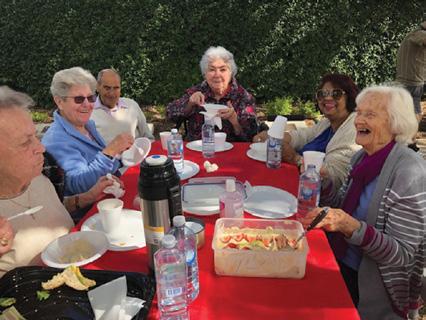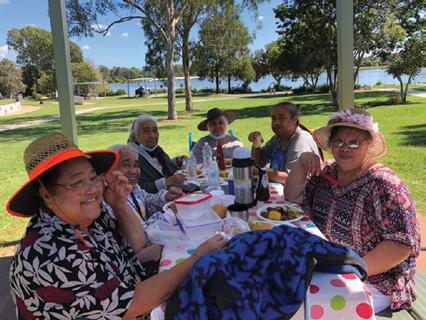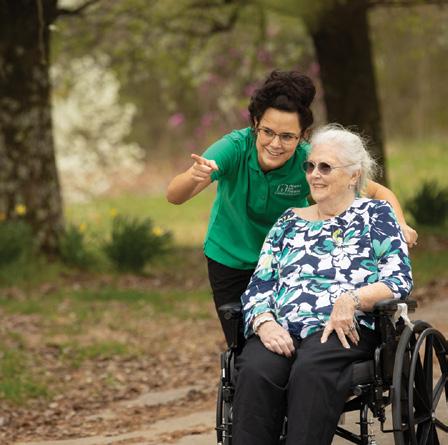
4 minute read
Home Support Programme Commonwealth Home Support Programme (CHSP)
If you want to stay in your own home, but need some help with daily tasks or require entry level care, the CHSP may be able to help.
The CHSP combines four Government funded home support programs into one streamlined and simplified program. They are:
Home and Community Care (HACC) program; National Respite for Carer Program (NRCP); Day Therapy Centres (DTC) program; and the Assistance with Care and Housing for the Aged (ACHA) program.
To determine if the CHSP is the right program for you, you will need to be assessed by a Regional Assessment Service (RAS). See page 22 for more information.
If you have more complex needs, a Home Care Package may be a better option. You can access similar services to the CHSP, coordinated and tailored to meet your specific needs (see page 31 for more details).
Contact My Aged Care on 1800 200 422 to find out how you can arrange a home support assessment.
What is CHSP?
Subsidised by the Australian Government, CHSP is an entry level home help program if you are mostly – but not completely – able to live and cope on your own, and don’t yet need higher levels of support at home.
The program can also help your carer. If your carer needs to attend to everyday activities, the CHSP can arrange for someone to help you while they are away.
What types of services are provided?
CHSP services provided in the community may include:
Social support – social activities in a community-based group setting
Transport – help to get out and about for shopping or appointments
Services provided at home may include:
Domestic assistance – household jobs such as cleaning, clothes washing and ironing
Personal care – help with bathing, showering, dressing, or toileting
Home maintenance – minor general repair and care of your house or yard, for example, changing light bulbs or replacing tap washers
Home modification – minor installation of safety aids such as alarms, ramps and support rails in your home
Nursing care – a qualified nurse comes to your home and may, for example, dress a wound or provide continence advice


Some CHSP services can be provided either at a community centre or in your home, such as:
Food services – may include providing meals at a community centre, help with shopping for food, preparing and storing food in your home, and delivering meals to your home.
Allied health support services – If you have particular health problems you may be able to access allied health services such as physiotherapy, podiatry, speech therapy, occupational therapy and advice from a dietitian.
Who is CHSP for?
You can apply for home help services under the CHSP if you are 65 years or older, or 50 years or older and identify as an Aboriginal and/or Torres Strait Islander person, are still living at home and need help to continue living independently.
You or your carer should contact the My Aged Care contact centre on 1800 200 422 or visit myagedcare.gov.au to apply.
Am I eligible?
To determine exactly what help you need at home, you will need a home support assessment. The assessment will be done by a representative of the Regional Assessment Service (RAS).
A local RAS assessor will look at your ability to cope with various activities in your daily living.
Together you will be able to work out what sort of help and how much you need, and what it might cost. Go to page 22 to read more about RAS assessments.
Urgent needs
If you’re in a situation where you have an urgent need for home support services and your safety would be at risk if those needs are not immediately met, it may be possible to receive CHSP services before you have been assessed by a RAS.
This only happens in exceptional circumstances and is only for a limited time until an assessment can be organised to determine long term care options.
Services generally considered to relieve an urgent need for care include nursing, personal care, meals and transport.
It will depend on your personal circumstances whether you’ll be able to receive interim services before an assessment. Call the My Aged Care contact centre on 1800 200 422 to find out more.
Who pays for CHSP services?
Supports delivered under CHSP are subsidised by the Government, however, there generally is still a fee for each service.
You are encouraged to contribute towards the cost of your care if you are able to do so.
The amount you contribute depends on the type and number of services you require and can differ from one service provider to the next.
Some organisations may charge a set fee for their services, while others may ask for a voluntary donation, charge a membership or subscription fee.
How much you pay is discussed and agreed upon between you and your service provider. The rate is set before you begin receiving the relevant services.
If you are receiving multiple services from one or more service providers and these services overlap, it may be possible to ‘bundle’ the cost for these services.
To find out specific costs you should contact your service provider.
Pre-1 July 2015 HACC, NRCP, DTC and ACHA clients
If you accessed Home And Community Care (HACC), National Respite for Carers Programme (NRCP), Day Therapy Centres (DTC) or Assistance with Care and Housing for the Aged (ACHA) prior to 1 July 2015, you may retain access to these services or equivalent CHSP services until other suitable services become available, or until the service is no longer required.
You can find CHSP funded services starting on page 182 of the directory section or online on AgedCareGuide.com.au

Home Care Packages
There are four different levels of packages to support people with varying care needs, ranging from Level 1 support, if you have basic care needs, to Level 4, which can support you if you have high level care needs.
The HCP is allocated to you personally, which gives you more control over the services you receive and who delivers those services.
Once you have been allocated a HCP you can contact any preferred approved service provider to give you the care you need.
Types of packages available
There are four types of packages delivering different levels of care:
1 Level 1 supports people with basic care needs
2 Level 2 supports people with low level care needs
3 Level 3 supports people with intermediate care needs

4 Level 4 supports people with high level care needs





